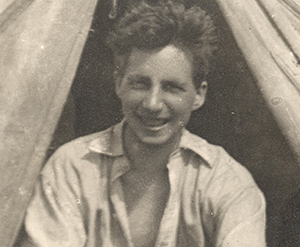Frank Flood and the Drumcondra ambush
Published in Issue 2 (March/April 2018), News, Volume 26Bridge over the River Tolka to be named after one of the ‘Forgotten Ten’.
By Seán Ryan

Above: Frank Flood—born in December 1901, he attended O’Connell’s CBS and won a scholarship to UCD, where he was studying engineering. A good friend of Kevin Barry, he was active with him in H Company, Dublin Brigade. (Kilmainham Gaol Museum)
Frank Flood (19) and his three comrades, Patrick Doyle (31), Bernard Ryan (20) and Thomas Bryan (24), executed in Mountjoy Jail on 14 March 1921, were four of the ‘Forgotten Ten’ whose bodies were exhumed from the jail in October 2001 and reinterred—nine in Glasnevin and one in County Limerick.
On the morning of Friday 21 January 1921, Flood and at least eight other members of Section One of the Active Service Unit (ASU), Dublin Brigade, IRA, took up ambush positions around Binn’s Bridge in Lower Drumcondra. The intended target was a lorryload of Black and Tans travelling between Dublin and their base in Gormanstown, Co. Meath. The ASU was armed with revolvers and hand grenades. After waiting some time at this location and with no sign of the expected enemy lorry, the decision was taken to move further north to the bridge over the Tolka. They set up a new ambush position just north of the bridge, directly opposite St Patrick’s National School, between Richmond Road and what is now Clonturk Park. There was a low wall fronting allotments on open ground to the rear, and the unit proceeded to make loopholes in the wall. At this stage a DMP sergeant named Thomas Singleton came on the scene and, despite misgivings expressed by others in the group, Flood decided not to detain him.
They were about to abandon the ambush when a lorry of British forces approached from the north, heading towards the city. They decided to attack: a grenade was thrown and shots fired. But almost immediately two British tenders and an armoured car arrived on the scene from the city direction; it was clear that the authorities had been notified about the ambush position.
Flood and four others (Doyle, Bryan, Ryan and Dermot O’Sullivan) ran down Richmond Road towards Ballybough but were met by two more tenders of Auxiliaries/RIC and were forced to turn up Grace Park Road and into Grace Park Gardens, where they were captured. Two others, Michael Magee and Seán Burke, raced across the open ground of Clonturk Park but were caught in a hail of bullets from a Lewis gun. Magee (24, Ostman Street, Arbour Hill) fell wounded, was helped up by Burke but was hit again. He was taken into custody and transferred to King George V (now St Bricin’s) Military Hospital, where he died the following morning. Seán Burke managed to escape the scene entirely; he entered a house nearby, posed as one of the family and, with the help of a young servant girl, managed to convince the Auxiliaries, who had traced him to the house, that he was completely uninvolved. Two other members of the ASU—Mick Dunne and Christopher ‘Kit’ O’Malley—also escaped the scene.
Frank Flood, Patrick Doyle, Thomas Bryan, Bernard Ryan and Dermot O’Sullivan were all charged with levying war against the Crown. Despite the fact that no member of the Auxiliary/RIC force had been killed or even wounded in the affair, they were sentenced to death. Dermot O’Sullivan, who was only seventeen, had his sentence commuted and the four others were hanged in Mountjoy Jail on 14 March 1921.
The IRA Volunteers who survived the ambush—Mick Dunne, Seán Burke, Kit O’Malley and Dermot O’Sullivan—subsequently joined the National Army on its inception in January 1922. Dunne’s luck ran out on 6 March 1923, when he was killed in a booby-trap mine explosion at Knocknagoshel, Co. Kerry. Burke appears to have left the National Army before the Civil War and subsequently emigrated to the USA. O’Sullivan and O’Malley both survived the war, and O’Malley (in a remarkable parallel with his better-known namesake, Ernie O’Malley) subsequently acted as military adviser in the making of the film Irish Destiny in 1926.
While the ambush on 21 January 1921 was a relatively minor affair, the execution of the four IRA Volunteers attracted much sympathetic attention both in Ireland and abroad. On the day of the hangings, a widespread work stoppage took place until midday in Dublin and thousands gathered outside Mountjoy Jail in sympathy. It is probably fair to say that the executions helped to focus minds on the peace overtures that were already taking place.
Seán Ryan is a local historian from Drumcondra.
FURTHER READING
Bureau of Military History Witness Statements, 508 (Dermot O’Sullivan), 1687 (Harry Colley), 536 (James Harper).
W.H. Kautt, Ambushes and armour—the Irish Rebellion 1919–1921 (Dublin, 2016).
Michael Noyk Papers, MS 36 226/1, National Library of Ireland.
















